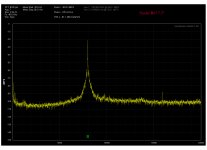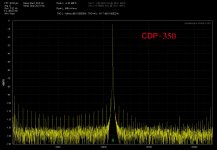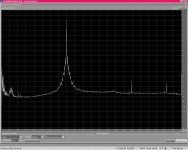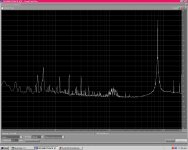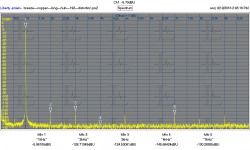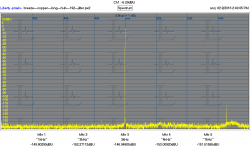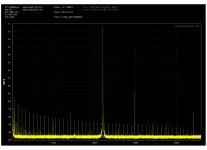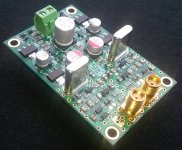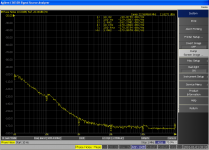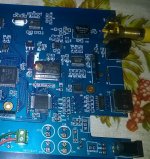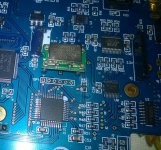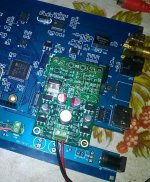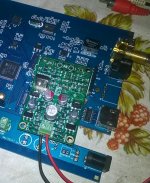I tested Crystek CCHD-957 and the performance was simply lousy.
I opened one up to figure out what was causing it (picture).
Inside is a plain Pierce oscillator based on a NC7SZ00 logic gate and a NC7SZ126 buffer. That explains a lot, it’s hardly better than an integrated oscillator in a CPU.
The phase noise plot just tells the story.
But the simple Pierce itself could be the best oscillator at this frequency, so what's wrong?
Used gates aside I believe the crystal makes the difference. Someone very known in the diy audio circle got -122dBc at 10 Hz from the carrier with a simple unbuffered '04 Pierce oscillator. He got this result using a 0.35 USD crystal strongly selected from a bag of them. Most of them were discarded because they performed very bad.
A good crystal (cold welded package, polish finish, harmonic rather than fundamental, high Q and so on) makes the difference regardless of the oscillator type.
That's the reason why Croven, Nofech and so on are still in business. Obviously their business is telecommunication, but their crystals (or similar from other brands) are a good starting point to get oscillators performing the highest short term stability.
TWTMC All in one
This is the TWTMC-AIO All in one combo oscillators.
There are 2 Driscoll oscillators at 22.5792 MHz and 24.576 MHz and 2 shunt regulators at 6V and 3V3.
It needs only a 9 to 12VDC unregulated or pre-regulated power supply.
Crystals are HC-49/U fundamental from TFC (Laptech's sister). Their specs are very good for a budget crystal in resistance welded package.
The board can be upgraded with Laptech HC-43/U crystals without any changing of the other parts.
This is the TWTMC-AIO All in one combo oscillators.
There are 2 Driscoll oscillators at 22.5792 MHz and 24.576 MHz and 2 shunt regulators at 6V and 3V3.
It needs only a 9 to 12VDC unregulated or pre-regulated power supply.
Crystals are HC-49/U fundamental from TFC (Laptech's sister). Their specs are very good for a budget crystal in resistance welded package.
The board can be upgraded with Laptech HC-43/U crystals without any changing of the other parts.
Attachments
I tested Crystek CCHD-957 and the performance was simply lousy.
I opened one up to figure out what was causing it (picture).
Inside is a plain Pierce oscillator based on a NC7SZ00 logic gate and a NC7SZ126 buffer. That explains a lot, it’s hardly better than an integrated oscillator in a CPU.
I had much better results with cheap NDK or Epson oscillators (2.5 x 2mm SMD version).
The oscillators were tested in the same circuit running on the same clean power supply.
It was connected to a discrete Mosaic multibit DAC that directly drives high ohmic Beyer Dynamics studio headphones (DC-coupled passive pure resistive output, no semiconductors) . This combination reveals much more that audio sets that add coloration and noise. So if there is anything "wrong" with the master clock, this setup will reveal it immediately.
Did you make any measurements of the Crystek? Was listening your only means of determining performance?
At this level implementation will hugely affect the performance. Things like ground bounce will seriously degrade the clocking after its left the oscillator. Making broad claims really requires evidence.
A well executed inverter based oscillator could be a fine solution. Wenzel suggests it. The Tinylogic inverter may be a good choice depending on whats inside it. The measured performance is on a par with the NDK oscillators. Have you opened an NDK? The NDK is so small its crystal will be tiny and that may affect it.
Oscillators integrated into the chip have major issues with interactions with other functions inside the chip so claiming an oscillator based on an IC won't perform is a little short sighted. Its all about context.
Your right in that a multibit dac will be much more sensitive to jitter. Which is a good argument to move past multibit DAC's.
Here are a number of high performance oscillators with explanations for the additional circuitry: Low Phase Noise Crystal Oscillators. The primary application for these is multiGHZ receivers where the multiplied phase noise is a real identifiable problem.
Your right in that a multibit dac will be much more sensitive to jitter. Which is a good argument to move past multibit DAC's.
No. The multibit DACs will have a much lower clock frequency and each decade less
gives 20 dB less phase noise, so this is probably moot.
The 100 MHz Crysteks are actually quite good, just really far out they leave to desire.
That's probably because Crystek cannot use inductors in the tiny package and without
them they cannot easily force transistor gains to zero near DC, and the amplified
AF noise mixes up.
I have not yet opened one b/c I would probably destroy it. But I got a vapour phase
soldering machine last week. It will take another month until I have the time to play
with it, but then opening them will be easy.
regards, Gerhard
My understanding is that Delta Sigma DAC's for some reason tend to have a reduced sensitivity to jitter (or so the chip vendors say). Certainly getting 20+ bits from a multibit dac is at or beyond current technology, something that will obscure jitter related noise.
Otherwise the clock timing on a multibit (actually the aperture jitter on the sample and hold) will be critical to its performance. Most current DAC chips use some of both technologies.
Have you measured a 24 MHz Crystek? Is there any reason to question their published performance? In a DAC or ADC my understanding is that phase noise above the sample rate is essential not part of the output so it won't matter. Also the phase noise at lower frequencies will affect the noise floor less. It seems unlikely that there would be enough phase noise to create audible wow or flutter artifacts at any level considered audible.
Otherwise the clock timing on a multibit (actually the aperture jitter on the sample and hold) will be critical to its performance. Most current DAC chips use some of both technologies.
Have you measured a 24 MHz Crystek? Is there any reason to question their published performance? In a DAC or ADC my understanding is that phase noise above the sample rate is essential not part of the output so it won't matter. Also the phase noise at lower frequencies will affect the noise floor less. It seems unlikely that there would be enough phase noise to create audible wow or flutter artifacts at any level considered audible.
Your right in that a multibit dac will be much more sensitive to jitter. Which is a good argument to move past multibit DAC's.
I'm not sure this is the reason why multibit dacs are coming out of the market. In my opinion the main reason is the cost of the manufacturing process (and their size).
Also Delta Sigma DACs are moving from 1 bit to multibit.
Since Delta Sigma are essentially "noise generators", they need high oversampling and noise shaping, that means high clock frequency. While a TDA1541 can operates at a few MHz clock without generating noise.
A 6 Mhz clock has far better phase noise than a 50 or 100 Mhz.
I agree with Lynn Olson, I had the same subjective impression comparing multibit R2R DAC with Delta Sigma
dac
My understanding is that Delta Sigma DAC's for some reason tend to have a reduced sensitivity to jitter (or so the chip vendors say).
My understanding is that only some of them do - the ones with output stages based on on-chip SC (switched cap) filters. Meaning any which are designed to use external opamps are fairly highly susceptible.
Flutter
Wow and flutter is a term I thought I never hear after I bought my firs CD player around 1983.
Old tape recorders comes in mind. Fortunately I'am a junk collector and in my basement is a Studer B67 and a bunch of test tapes. So I was running a test to see differences tape vs. CDP. Since the human sound recorded heritage fom the late 40's to ca. the late 80's was created on reel to reel machines ,and I don't hear complains about flutter in the piano recordings and I personally satisfied with those old records, I take it as a reference for audible flutter threshold. Since the last tree years I measured ca, 50 CDP's and DAC's with my QA400, I take the worst of them the Sony CDP-350 and the Wakibaki's Jitter3 track to compare to the tape recorder.
Wow and flutter is a term I thought I never hear after I bought my firs CD player around 1983.
Old tape recorders comes in mind. Fortunately I'am a junk collector and in my basement is a Studer B67 and a bunch of test tapes. So I was running a test to see differences tape vs. CDP. Since the human sound recorded heritage fom the late 40's to ca. the late 80's was created on reel to reel machines ,and I don't hear complains about flutter in the piano recordings and I personally satisfied with those old records, I take it as a reference for audible flutter threshold. Since the last tree years I measured ca, 50 CDP's and DAC's with my QA400, I take the worst of them the Sony CDP-350 and the Wakibaki's Jitter3 track to compare to the tape recorder.
Attachments
Wouldn't it be feasible to consider how to "reduce" the output voltage of the 74HC04/74HCU04 in a "jitter adequate way" so that it may still be fed this high 6.5 VDC PSU voltage - yet its output is at a level where it's compatible with the most likely DACs/ADCs to be used (3.3 or 5 VDC logic levels)?
Up to 25 MHz I think you could use the Wenzel two-transistor differential amplifier with a pair of MMBTH81. You can get the output voltage you want simply varying the 270R resistor.
Those measurements do highlight some of the important questions about sensitivity. As poor at the CDP looks in the plot the B67 is just much greater. It would take some sophisticated signal processing to get the 250 Hz component out of the noise if its there.
A higher resolution plot of the B67 would show the power line modulation (50 Hz?) plus once around for the capstan motor and the reel motors. Scrape flutter will not have as clear a noise spike since its somewhat broadband but will contribute, possibly in spreading out the peaks. Still those were considered not audible and now we are chasing artifact 20 dB lower. The artifacts that will really matter are the deterministic (clear single frequency) that show up.
A higher resolution plot of the B67 would show the power line modulation (50 Hz?) plus once around for the capstan motor and the reel motors. Scrape flutter will not have as clear a noise spike since its somewhat broadband but will contribute, possibly in spreading out the peaks. Still those were considered not audible and now we are chasing artifact 20 dB lower. The artifacts that will really matter are the deterministic (clear single frequency) that show up.
Hi all,
@Andrea,
Thanks for the feedback & suggestion. I have been considering myself as well and yesterday evening I think I've found a "simple" solution which is to be a bit hard on a 74LVC04. It accepts input voltages up to 6.5 volts while still running at a 3.3 VDC PSU so in this case it will be feasible for my purposes.
BTW I also read the article by Lynn Olson some time ago. Interesting observations .. As it is I happen to know a person who has a very large living room and who has a quite good DAC based on the PCM63. I've modified it with a Tent Labs clock (some years ago) and various and it may be outstanding in some respects - not least with low level signals. I don't know how the setup would be with a delta sigma DAC though but intuitively I lean towards the "no-processing" that may be involved with multi-bit DACs.
@abraxalito/1audio:
Some years ago I read into a book by (I think his name was) Schreier about delta-sigma conversion theory and practice. And one of the conclusions I remember from reading the book was that delta-sigma ADCs (and thus I don't know if it also relates to DACs) based on a switched capacitor topology was much less sensitive to jitter than topologies based on a continuous time topology. Maybe an expression of fine design practice that Grimm Audio's AD1 DSD converter:
AD1 | GrimmAudio
- which to my knowledge is based on a continuous time topology - (among others designed by Bruno Putzeys and maybe Herbert?) has such a fine reputation for its sound as it appears to have ....
Cheers,
Jesper
@Andrea,
Up to 25 MHz I think you could use the Wenzel two-transistor differential amplifier with a pair of MMBTH81. You can get the output voltage you want simply varying the 270R resistor.
Thanks for the feedback & suggestion. I have been considering myself as well and yesterday evening I think I've found a "simple" solution which is to be a bit hard on a 74LVC04. It accepts input voltages up to 6.5 volts while still running at a 3.3 VDC PSU so in this case it will be feasible for my purposes.
BTW I also read the article by Lynn Olson some time ago. Interesting observations .. As it is I happen to know a person who has a very large living room and who has a quite good DAC based on the PCM63. I've modified it with a Tent Labs clock (some years ago) and various and it may be outstanding in some respects - not least with low level signals. I don't know how the setup would be with a delta sigma DAC though but intuitively I lean towards the "no-processing" that may be involved with multi-bit DACs.
@abraxalito/1audio:
My understanding is that only some of them do - the ones with output stages based on on-chip SC (switched cap) filters. Meaning any which are designed to use external opamps are fairly highly susceptible.
Some years ago I read into a book by (I think his name was) Schreier about delta-sigma conversion theory and practice. And one of the conclusions I remember from reading the book was that delta-sigma ADCs (and thus I don't know if it also relates to DACs) based on a switched capacitor topology was much less sensitive to jitter than topologies based on a continuous time topology. Maybe an expression of fine design practice that Grimm Audio's AD1 DSD converter:
AD1 | GrimmAudio
- which to my knowledge is based on a continuous time topology - (among others designed by Bruno Putzeys and maybe Herbert?) has such a fine reputation for its sound as it appears to have ....
Cheers,
Jesper
Those measurements do highlight some of the important questions about sensitivity. As poor at the CDP looks in the plot the B67 is just much greater. It would take some sophisticated signal processing to get the 250 Hz component out of the noise if its there.
A higher resolution plot of the B67 would show the power line modulation (50 Hz?) plus once around for the capstan motor and the reel motors. Scrape flutter will not have as clear a noise spike since its somewhat broadband but will contribute, possibly in spreading out the peaks. Still those were considered not audible and now we are chasing artifact 20 dB lower. The artifacts that will really matter are the deterministic (clear single frequency) that show up.
The problem is that the QA400 has a long settling time in high resolution , and the test tape tracks are to short for that (maybe my computer is to slow). I made a recording in the computer and used the Cool Edit to analyze the file. The test made in Toronto, so it's 60Hz and it's harmonics. The Studer has Papst type outer rotor motors, which are generating less of the disturbing fields. The program not allowing to zoom in close to skirt so it's difficult to see details of the modulation noise.
I bought two of Andrea's boards and I now have two Laptech crystals, I can start to populate the boards and with time I can run a test with the help of Wakibaki's test track. I measured much better CD players than the above Sony one, also tried to swap crystals in them and saw differences in the jitter tracks skirt. So that would give a hint of the performance of the oscillator.
Attachments
Your computer is fast enough. High resolution measurements need lots of samples, and averaging still more. You are getting good data. In the CD players if the crystal is tied directly to a processor chip the chip will jhave a lot of influence on the system. Most likely any logic action will modulate the oscillator. What works well for me is to leave the stock crystal in place and injection lock the on board oscillator from a more stable external clock. Typically 10 pF to the input side of the internal gate is enough to lock to the external oscillator. Usually it doesn't disturb the local oscillator when disconnected either.
Good news about my old XP computer, thanks 1audio.
The oscillator trick you describing is also new to me, I will certainly try it.
Some members of Diyaudio promoting the idea to apply or tie the clock first to the DAC and distribute it from there to the rest of the circuitry for reduced jitter.
The oscillator trick you describing is also new to me, I will certainly try it.
Some members of Diyaudio promoting the idea to apply or tie the clock first to the DAC and distribute it from there to the rest of the circuitry for reduced jitter.
Just as a reference here is the jitter measurement I made recently of a modest USB DAC (Xmos U8 AK4490 Audio HiFi Asynchronous USB Decoder DAC with Headphone Out PSU | eBay)
Its formatted as closely to the Stereophile measurements as I can with different hardware. Essentially free of jitter/phase noise artifacts. The unit has two small crystal oscillators of unknown origin. It also has very low distortion if you swap the original socketed opamp. I used an LME49720. If this is the baseline, it will be hard to improve upon.
I have measured some older premium DACs that were not as good but technology marches on and they aren't relevant any more.
Hi Demian,
Could you please tell me, which USB driver you used in connection with the Breeze Audio USB DAC? I have a laptop with Win 7, and I have a problem to get it working.
Thanks
The driver situation is a mess for this stuff. (In Linux it just works) however i think this is the driver I'm using http://www.sotm-audio.com/sotmwp/english/?wpdmact=process&did=MjguaG90bGluaw== At least thats what Windows says. I installed it to use an SOTM DAC but that still did not work right.
The other driver I tried http://www.xmos.com/published/usb-audio-class-20-evaluation-driver-windows?version=latest I think worked but did not with the SoTM. In Win 10 you can't really hack the driver for different PID stuff. if neither work let me know and I'll dig further.
As near as I can tell they are using the demo firmware from Xmos and may have made no changes since it enumerates as an XMOS XS1-U8 device. I would like to see a firmware for this with the volume control enabled for the DAC.
I'm looking at getting a different, more expensive, platform to play with, especially because it has SPDIF in, which I need for testing. I'll provide more when I have more details.
Below is a distortion plot from the Breeze (modified with a LME49720 opamp) and a jitter plot of 48 KHz at a 192 KHz sample rate similar to the usual jitter plots except no 1 bit modulation. Its completely clean of jitter artifacts. One tip, the power supply must be 12V or more or you get distortion. I don't think the one they supplied was. These were made with a generic switching supply. I tried a linear supply and got a lot of 60 Hz modulation on the clock for some reason.
The other driver I tried http://www.xmos.com/published/usb-audio-class-20-evaluation-driver-windows?version=latest I think worked but did not with the SoTM. In Win 10 you can't really hack the driver for different PID stuff. if neither work let me know and I'll dig further.
As near as I can tell they are using the demo firmware from Xmos and may have made no changes since it enumerates as an XMOS XS1-U8 device. I would like to see a firmware for this with the volume control enabled for the DAC.
I'm looking at getting a different, more expensive, platform to play with, especially because it has SPDIF in, which I need for testing. I'll provide more when I have more details.
Below is a distortion plot from the Breeze (modified with a LME49720 opamp) and a jitter plot of 48 KHz at a 192 KHz sample rate similar to the usual jitter plots except no 1 bit modulation. Its completely clean of jitter artifacts. One tip, the power supply must be 12V or more or you get distortion. I don't think the one they supplied was. These were made with a generic switching supply. I tried a linear supply and got a lot of 60 Hz modulation on the clock for some reason.
Attachments
Thanks for the extensive reply.
I also found some XMos USB drivers on the net, most of them are downloaders, not stand alone exe programs.
What is bothering me, that I have to sign up for most of the websites if I want to download the free driver.
As it now I have pages of user names and the associated passwords, and on the top of it I have to give them my email address to.
I found this site ( Drivers - I2S over USB Audio ), where I could just click on downloader and it would get me the downloader rar file, no sign up needed.
I used the XMOS-USB-Audio-(v2.23.0).rar which worked on three different computers (Vista, Win7 and xp).
Opening up the unit I found the JRC5532 running on single supply ca. 7.5V, so I will search for a 12V AC adapter ,as you suggested. The crystal oscillators are made by SCTF in China.
Buy crystal oscillator, crystal oscillator for sale from shenzhen-sctf-electronics-co[ of page N]
Your measurements are very impressive, here's the jitter spectrum as the QA400 sees it, the source is Wakibaki's Jitter3 file running on a laptop computer, on the unmodified Breeze Audio USB DAC. I don't know the source of the 15kHz signal. The rest of the results will go to the QA400 thread, since this is Andrea's oscillator thread.
I also found some XMos USB drivers on the net, most of them are downloaders, not stand alone exe programs.
What is bothering me, that I have to sign up for most of the websites if I want to download the free driver.
As it now I have pages of user names and the associated passwords, and on the top of it I have to give them my email address to.
I found this site ( Drivers - I2S over USB Audio ), where I could just click on downloader and it would get me the downloader rar file, no sign up needed.
I used the XMOS-USB-Audio-(v2.23.0).rar which worked on three different computers (Vista, Win7 and xp).
Opening up the unit I found the JRC5532 running on single supply ca. 7.5V, so I will search for a 12V AC adapter ,as you suggested. The crystal oscillators are made by SCTF in China.
Buy crystal oscillator, crystal oscillator for sale from shenzhen-sctf-electronics-co[ of page N]
Your measurements are very impressive, here's the jitter spectrum as the QA400 sees it, the source is Wakibaki's Jitter3 file running on a laptop computer, on the unmodified Breeze Audio USB DAC. I don't know the source of the 15kHz signal. The rest of the results will go to the QA400 thread, since this is Andrea's oscillator thread.
Attachments
First, use a 12V or more DC supply. There are no rectifiers in the unit. At less that 12V the audio starts clipping at FS.
Second, jitter shows up as symmetrical tones around the dominant carrier. In your case 12KHz. The two strong tones are jitter I think and may be an artifact of the power supply or the USB packet rate. Another jitter frequency common in USB comes from the USB signalling- its either at 1 KHz or 4 KHz, the packet rate for USB. That may get in through grounding in some way. Fiddling with power supplies, grounding, wire layout etc. may help isolate the source of the jitter. The QA400 is not ground isolated so you may get something from the two separate USB devices have grounds connected together. if you can use separate computers and isolate that way it may go away.
Second, jitter shows up as symmetrical tones around the dominant carrier. In your case 12KHz. The two strong tones are jitter I think and may be an artifact of the power supply or the USB packet rate. Another jitter frequency common in USB comes from the USB signalling- its either at 1 KHz or 4 KHz, the packet rate for USB. That may get in through grounding in some way. Fiddling with power supplies, grounding, wire layout etc. may help isolate the source of the jitter. The QA400 is not ground isolated so you may get something from the two separate USB devices have grounds connected together. if you can use separate computers and isolate that way it may go away.
TWTMC All in One phase noise
Attached the measured phase noise of the Driscoll All in One oscillator board. The crystal is a budget resistance welded HC-49/U AT-Cut from TFC.
The plot shows that the phase noise close to the carrier is better than the Crystek at the same frequency, and much better than the Crystek one at 1 Khz from the carrier and above.
Keep in mind that I have randomly picked a crystal from the bag of samples I received from TFC, no selection was done. While, probably, the phase noise plot in the Crystek datasheet shows the best performer they have measured.
Attached the measured phase noise of the Driscoll All in One oscillator board. The crystal is a budget resistance welded HC-49/U AT-Cut from TFC.
The plot shows that the phase noise close to the carrier is better than the Crystek at the same frequency, and much better than the Crystek one at 1 Khz from the carrier and above.
Keep in mind that I have randomly picked a crystal from the bag of samples I received from TFC, no selection was done. While, probably, the phase noise plot in the Crystek datasheet shows the best performer they have measured.
Attachments
Listening session
I have just compared a few oscillators in a listening session. The comparison was done in the same audio chain, simply replacing the oscillator board at each session. I'm tweaking a chines SD card player for a friend, so I used it to compare the oscillators. For this listening session I have used the S/PDIF output of the player (Aune X5 that provides also I2S output), since the DAC (NOS with AD1865) accepts S/PDIF input only.
I performed the listening session with a friend. During the comparison I knew which oscillator was playing at every moment, while for my friend this was a blind session. At the end of the session we have assigned a score from 0 to 10 points to each oscillator, reporting the listening impressions.
I don't like to publish listening impressions, since they are subjective and not measurable. So, I invite everyone to do his own comparison to evaluate the difference. What I can claim is that there are clearly audible differences, in most cases the difference is huge.
It's very impressive that replacing the clock in the same audio chain, the sound changes totally.
These are the oscillators that were compared, all at 22.5792 MHz:
- original Aune XO
- Crystek CCHD-957
- TWTMC-AIO Driscoll All in One with standard HC-49/U AT-Cut crystal from TFC
- TWTMC-AIO Driscoll All in One with cold welded HC-43/U AT-Cut crystal from Laptech
- TWTMC-P Pierce with cold welded HC-43/U AT-Cut crystal from Laptech
Following the score and the listening impressions for each oscillator:
1) Score: 9. The best performers (ex-aequo) are the TWTMC-P Pierce and the TWTMC-AIO Driscoll with the same Laptech HC-43/U AT-Cut crystal. Performance of these oscillators are very similar and far better than the others. There are only a little differences between the two oscillators, not more than a little shades, that's the reason they win the comparison ex-aequo. Bass are deep and controlled, the Pierce is a little less deeper but more dumped, the Driscoll is a little more "rounded". Vocals are spectacular in both cases, with the Driscoll a little smoother, although a little backward. The upper octaves are very good for both oscillators, the Pierce is a little more detailed and a little less smoother. The soundstage is very wide and high, the Pierce reach the maximum extension. Unplugged music is so realistic with both the oscillators, with the Pierce more detailed and the Driscoll a little smoother. Hard to choose between the two oscillators, after a long debating I chose the Driscoll while my friend opted for the Pierce. But as I said before they are simple shades, both oscillators perform very good. I suspect that the Driscoll with harmonic SC-Cut will be the winner with a score of 10.
2) Score: 7.5/8-. The second place was assigned to the TWTMC-AIO Driscoll with the TFC HC-49/U AT-Cut crystal. Its performance is similar to the Driscoll with Laptech HC-43/U crystal, although the differences are audible. Bass are a little lighter but very controlled. Vocals are a little more thin compared to its big brother, but very nice anyway, never aggressive. High are very detailed and smooth. The soundstage is a little compressed compared to best performers, the image is stable and realistic. Where the difference is clearly audible is about the complex music such as the full Orchestra, in this case the result is a little confused, while the Pierce and the big Driscoll don't suffer of this issue. All in all the sonic performance of this oscillator is very respectable , considering that uses an inexpensive crystal. As I stated many times the crystal makes the difference.
3) Score: 5. With the Crystek oscillator the differences are huge and clearly audible after the first notes. If the Driscoll with the budget crystal can be defined similar to the best performers of the group, although the differences exist and they are audible, the Crystek sounds harsh and confused. Bass lacks of thickness and is boomy. Vocals are confused and aggressive, they get you tired after a few minutes of listening. The soundstage is narrow and shallow, the image is less stable than the previous oscillators. Orchestra is totally confused and kneaded. All in all the resulting sound is very poor, far worse than the previous 3 oscillators.
4) Score: 4. The original Aune oscillator is the worst of the group, although not much worse than the Crystek. It has the same shortcomings of the Crystek in all respects although more prominent.
I have just compared a few oscillators in a listening session. The comparison was done in the same audio chain, simply replacing the oscillator board at each session. I'm tweaking a chines SD card player for a friend, so I used it to compare the oscillators. For this listening session I have used the S/PDIF output of the player (Aune X5 that provides also I2S output), since the DAC (NOS with AD1865) accepts S/PDIF input only.
I performed the listening session with a friend. During the comparison I knew which oscillator was playing at every moment, while for my friend this was a blind session. At the end of the session we have assigned a score from 0 to 10 points to each oscillator, reporting the listening impressions.
I don't like to publish listening impressions, since they are subjective and not measurable. So, I invite everyone to do his own comparison to evaluate the difference. What I can claim is that there are clearly audible differences, in most cases the difference is huge.
It's very impressive that replacing the clock in the same audio chain, the sound changes totally.
These are the oscillators that were compared, all at 22.5792 MHz:
- original Aune XO
- Crystek CCHD-957
- TWTMC-AIO Driscoll All in One with standard HC-49/U AT-Cut crystal from TFC
- TWTMC-AIO Driscoll All in One with cold welded HC-43/U AT-Cut crystal from Laptech
- TWTMC-P Pierce with cold welded HC-43/U AT-Cut crystal from Laptech
Following the score and the listening impressions for each oscillator:
1) Score: 9. The best performers (ex-aequo) are the TWTMC-P Pierce and the TWTMC-AIO Driscoll with the same Laptech HC-43/U AT-Cut crystal. Performance of these oscillators are very similar and far better than the others. There are only a little differences between the two oscillators, not more than a little shades, that's the reason they win the comparison ex-aequo. Bass are deep and controlled, the Pierce is a little less deeper but more dumped, the Driscoll is a little more "rounded". Vocals are spectacular in both cases, with the Driscoll a little smoother, although a little backward. The upper octaves are very good for both oscillators, the Pierce is a little more detailed and a little less smoother. The soundstage is very wide and high, the Pierce reach the maximum extension. Unplugged music is so realistic with both the oscillators, with the Pierce more detailed and the Driscoll a little smoother. Hard to choose between the two oscillators, after a long debating I chose the Driscoll while my friend opted for the Pierce. But as I said before they are simple shades, both oscillators perform very good. I suspect that the Driscoll with harmonic SC-Cut will be the winner with a score of 10.
2) Score: 7.5/8-. The second place was assigned to the TWTMC-AIO Driscoll with the TFC HC-49/U AT-Cut crystal. Its performance is similar to the Driscoll with Laptech HC-43/U crystal, although the differences are audible. Bass are a little lighter but very controlled. Vocals are a little more thin compared to its big brother, but very nice anyway, never aggressive. High are very detailed and smooth. The soundstage is a little compressed compared to best performers, the image is stable and realistic. Where the difference is clearly audible is about the complex music such as the full Orchestra, in this case the result is a little confused, while the Pierce and the big Driscoll don't suffer of this issue. All in all the sonic performance of this oscillator is very respectable , considering that uses an inexpensive crystal. As I stated many times the crystal makes the difference.
3) Score: 5. With the Crystek oscillator the differences are huge and clearly audible after the first notes. If the Driscoll with the budget crystal can be defined similar to the best performers of the group, although the differences exist and they are audible, the Crystek sounds harsh and confused. Bass lacks of thickness and is boomy. Vocals are confused and aggressive, they get you tired after a few minutes of listening. The soundstage is narrow and shallow, the image is less stable than the previous oscillators. Orchestra is totally confused and kneaded. All in all the resulting sound is very poor, far worse than the previous 3 oscillators.
4) Score: 4. The original Aune oscillator is the worst of the group, although not much worse than the Crystek. It has the same shortcomings of the Crystek in all respects although more prominent.
Attachments
Last edited:
- Status
- Not open for further replies.
- Home
- Source & Line
- Digital Line Level
- The Well Tempered Master Clock - Building a low phase noise/jitter crystal oscillator

